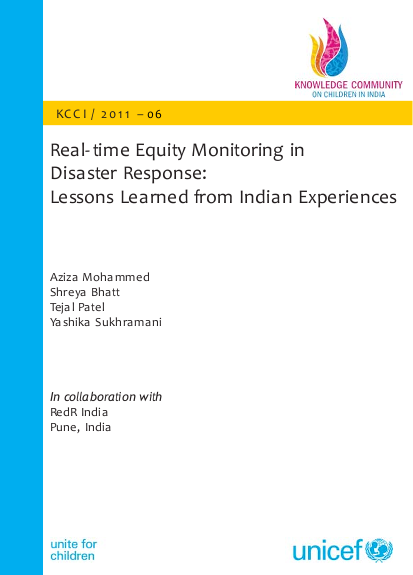
Disasters do not occur in isolation. They are instead inextricably linked with the social, cultural, economic and political contexts that shape the development of society. India’s social fabric is a weave of many identities such as caste, ethnicity, and religion. Such stratification over time has created social, economic, political and geographic inequities faced by groups such as Scheduled Castes and Tribes, women, children, the disabled, and the elderly. During disasters, such development inequities get exacerbated, and the access of these vulnerable groups to time-critical, life-saving rescue, relief and rehabilitation entitlements is restricted. Thus the need arises for real-time equity monitoring to ensure that vulnerable groups have equal access to relief and rehabilitation entitlements as per their specific needs, and when those needs come to light. This study sought to explore and analyse the elements, desirable qualities and structure of a real-time equity monitoring system that can be used by the disaster management community in India and beyond. This was done by examining real-time equity monitoring experiences that emerged in response to three major natural disasters in India: the 2009 drought in Rajasthan, the 2008 Kosi floods in Bihar and the 2004 tsunami in Tamil Nadu. Disasters are of various kinds, and their impacts differ based on varied contexts. Through the analysis of these three distinct experiences, however, the report provides a comprehensive understanding of the diverse learnings that emerge in different contexts. The analysis of these cases reveals the key challenges, potential, and enabling factors of an equity monitoring mechanism. It also reveals desirable qualities that a monitoring mechanism should possess for a timely, inclusive, and needs-sensitive disaster response. The present analysis shows that several challenges hinder the implementation of real-time equity monitoring in a disaster response. These include: differences in stakeholder mandates; common perceptions of threat that monitoring creates; the perceived reluctance of Government and civil society to collaborate; general perceptions of relief as charity; people’s perceptions of vulnerability; a limited understanding of specific needs of different vulnerable groups; and lack of proper methods to facilitate monitoring in a non-threatening and non-offensive manner. The study suggests that the potential of equity monitoring in disaster response can be viewed in two ways: first, in terms of its ability to enhance the quality of humanitarian response and second, in terms of both its short-term outcome of providing timely grievance resolution and its longer-term impact of restoring the assets of vulnerable populations and empowering them.7 Further, the study reveals that the quality of real-time equity monitoring is influenced by external and internal factors such as: transparency and awareness based on information exchange and capacity building, active leadership, multi-stakeholder collaboration and coordination, governance structures, and availability of resources.
